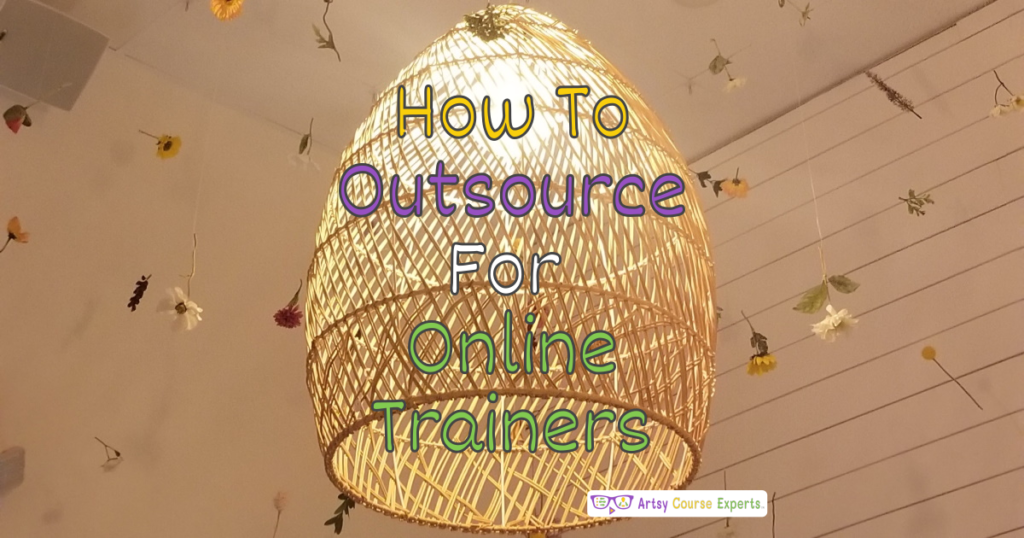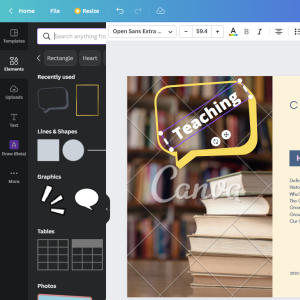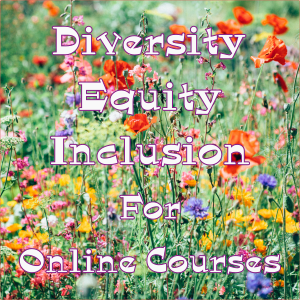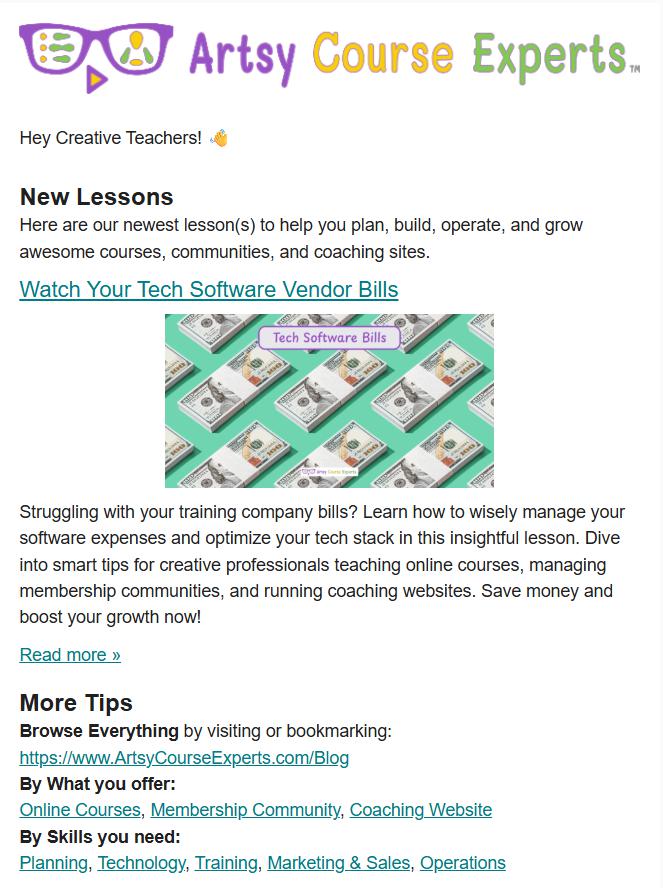Introduction
When did you first realize that you were creative? Was it during your first dance recital in 1st grade? Have you been singing since you could remember? Maybe you just discovered that you love creative writing.
As creative teachers, all of us have experienced a pivotal moment in which we realized that we possessed a creative spark. We recognized that we had a natural gift or skill to express ourselves in an outstanding way, and others appreciated our art.
Well, did you know that these creative sparks can be categorized? That’s right. Everyone has a specialized set of skills and knowledge that contributes to their own understanding of certain topics.
In the psychology world, there is a theory that explains how we get these “sparks” and how they can be applied to our careers. This theory is known as the theory of multiple intelligences. Let’s learn more about its origins and how to apply it to our creative courses.
What Is the Theory of Multiple Intelligences?
The theory of multiple intelligences was created by Howard Gardner, a psychologist and Research Professor of Cognition and Education at Harvard. In 1983, he explained his theory in one of his first books, presenting the idea that people are not born with all the intelligence they will have during their lifetime and that they will acquire new knowledge as time progresses.
Outside of the general intelligence type, which assumes that all students learn in the same way, Gardner proposed 8 other intelligence types that each person has at various levels.
Before we jump into each intelligence type, it’s important to note that while it may be tempting to lump your students into one category, you may want to think twice.
Everybody doesn’t possess the natural skills needed to participate in a hobby or complete a task, and that’s where you come in as a creative teacher!
A few examples are provided to help you understand the theory, but it is not a comprehensive list, nor does it 100% describe each one of your students! The theory should be used as a guide, not as a way to strictly define your students.
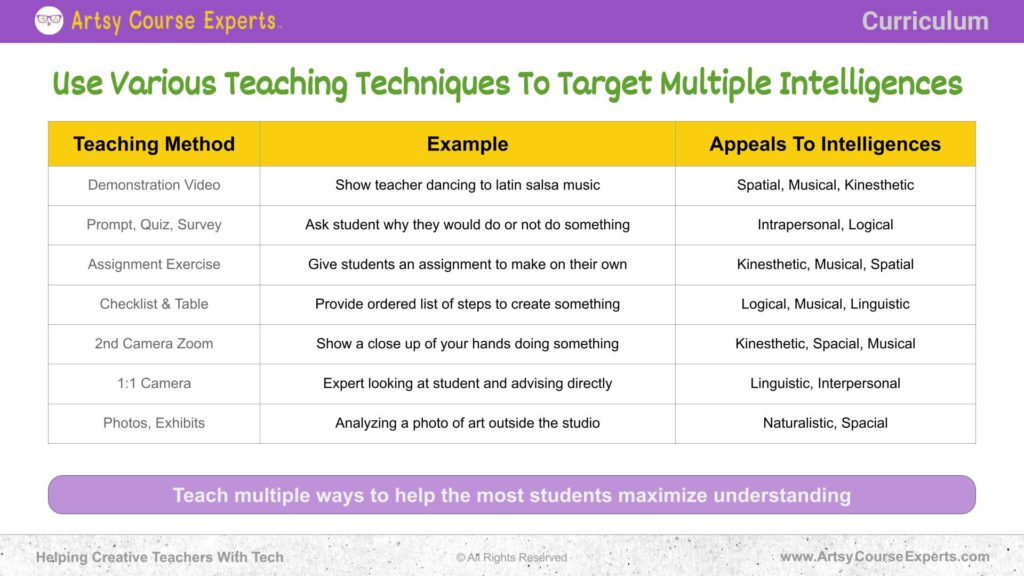
Various Types of Intelligences
Linguistic Intelligence
People with this type of intelligence have a way with words. They know exactly how to express themselves through written and spoken language, and they can also interpret the words of others in a careful and concise way. Creative writers, authors, poets, and bloggers may have this intelligence type.
Musical Intelligence
This one’s easy! If you play an instrument, sing, write music, or have any sort of musical talent, you definitely have some musical intelligence. Beyond singing in the shower, creatives with this intelligence have an eye (and an ear!) for what sounds good. Those with other intelligence types, such as bodily or linguistic intelligence, may also share some musical intelligence.
Logical-Mathematical Intelligence
People with this type of intelligence are natural problem solvers. They use math, science, and reasoning to create solutions. At first glance, this intelligence type may not seem to have a place in the creative world, but it absolutely does. Fashion designers, sketch artists, jewelry makers, and the like need to be familiar with mathematical and scientific principles to create the best product.
Interpersonal Intelligence
If you’re reading this article, congratulations—you have interpersonal intelligence! Creatives with this ability understand what motivates people and helps them reach their fullest potential. As someone who’s interested in teaching, it’s important to have a high level of interpersonal skills.
Intrapersonal Intelligence
Aside from understanding others, understanding yourself is probably one of the most important skills to have. People who understand themselves are self-aware and insightful. You know how to self-motivate and achieve your goals. These types of creatives would make excellent entrepreneurs.
Bodily-Kinesthetic Intelligence
Creatives with this intelligence know how to use their bodies (or a part of their bodies) to demonstrate a skill or to create a product. Dancers certainly fall under this category, but so do sculptors and craftsmen.
Visual and Spatial Intelligence
People with spatial intelligence are experts at perceiving the dimensions within a large or small space. Typically, they are good with refining shapes and objects, like a sculptor or animator would.
Naturalist Intelligence
Last but not least are those with naturalist intelligence. These types of intellectuals love plants, animals, and other natural elements. Florists and botanists are just a few examples of creatives that fall under this category.
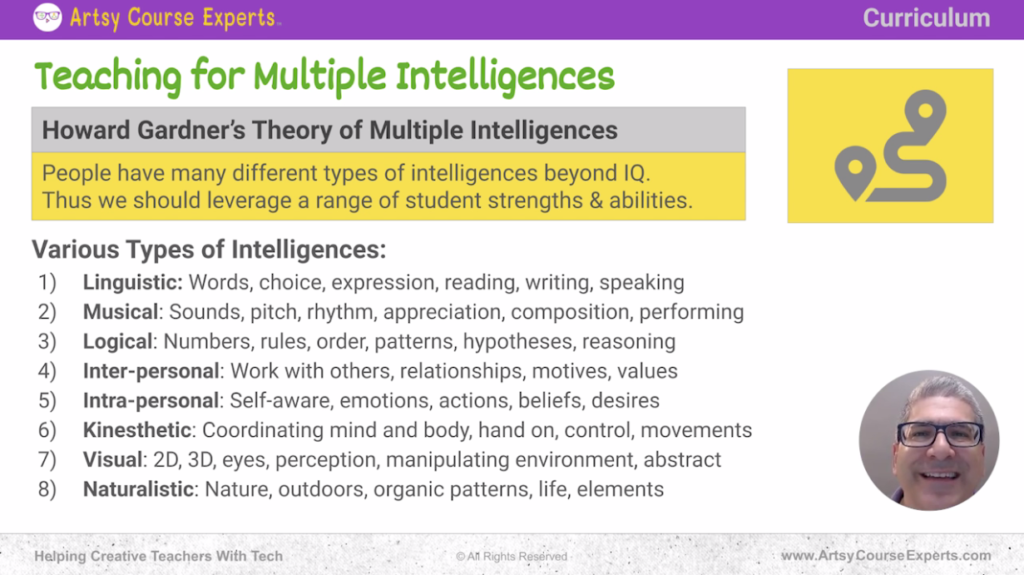
Empowering Potential Customers Through the Theory of Multiple Intelligences
As we mentioned earlier, everyone has varying levels of each intelligence. To get a better understanding, you can take a quiz to review your own multiple intelligences.
As a creative teacher, using the theory of multiple intelligences can help you create a well-rounded course that challenges and fulfills your students in multiple ways.
Sometimes, students just don’t know what they’re looking for in a course. Maybe they just want to pick up a new hobby. Maybe they’re looking to elevate a specific skill that they already have.
Either way, you want to ensure that the students coming your way are well-informed about your course and how it fits their needs. For potential students, knowing their intelligence types could prevent course dropouts, bad reviews, and poor experiences in the long run. You might have one of the best online courses on the market, but if it isn’t a good fit for your customer, it won’t be a good course for them.
You can help your potential customers make the best decision by helping them reflect on their past interests and current goals. Try adding a multiple intelligences quiz to your course landing page or by asking a few rhetorical questions (ex.- Do you want to take your salsa dancing skills to the next level? Are you ready for live dancing lessons with real time feedback?).
Developing Your Students Through the Theory of Multiple Intelligences
Now that your students are well informed, you can now find ways to incorporate them into your course assignments. Remember—you shouldn’t focus on one intelligence type, nor should you stress yourself out trying to incorporate all of them into every assignment. Remember, everyone has some degree of every intelligence, and incorporating them throughout your course will be beneficial.
For example, some things that a photography student may learn are:
- How to operate various types of cameras
- The basics of indoor and outdoor lighting
- The best angles to take photos
These three skills alone require mathematical, spatial, and naturalist intelligence. Don’t shy away from challenging your students to strengthen their skills because an assignment seems unrelated. Explore the relationship between music and photography. Have your students explore how body language influences photography. These assignments may not be related to the obvious intelligences, but they are definitely related to the topic at hand.
Some Drawbacks of the Theory of Multiple Intelligences
While the theory is great for exploring and strengthening new skills, it can also limit student potential if it’s not used properly.
As previously mentioned, the theory should be used to guide your students and encourage them. Many people become discouraged when learning a new skill.
Remind your students that they will learn everything they need to know throughout the class and that they don’t have to know everything upfront.
If you give your students access to the multiple intelligence quiz, it may be helpful to create a discussion board post that allows students to discuss their results and how they can use them to be successful during your course. Again, it’s a resource that is meant to empower, not stifle!
Using Various Teaching Techniques to Target Multiple Intelligences
As a teacher, you may want to target multiple intelligences. Remember, people can be intelligent in a couple of different ways. As a community leader or teacher, you may want to use a variety of tools to teach these different kinds of students.
- As an example, you may want to use demonstration videos. For instance, a video showing a teacher dancing to latin salsa music will help students who are really great at spacial music and kinesthetic intelligences.
- You may want to use prompts or surveys for students that are great at interpersonal and logical. A good example is asking students why they would or nor do something.
- Giving assignment exercises to make on their own helps students that are into kinesthetics music spatial.So they end up making something on their own.
- You might provide checklists or tables for students that are naturally gifted in logical musical or linguistic, and they prefer to read and, digest their information
- You may use a second camera or zoom into your hands to demonstrate something if you’re teaching to kinesthetic, spatial, or musical intelligences.
- You may want to talk directly into the camera for some students that need that extra interpersonal or linguistic where they really wanna listen to your choice of words.
- Finally, you may want to use photos of something outside the studio, that would be great for spatial or obviously naturalistic intelligence.
Frequently Asked Questions about Multiple Intelligences

Summary of the Multiple Intelligences Theory
The theory of multiple intelligences was introduced by Howard Gardner. He stated that although people are born with innate intelligence, they will acquire more knowledge throughout life. These intelligences can be separated into the following 8 categories:
- Linguistic
- Logical-mathematical
- Spatial
- Bodily-kinesthetic
- Musical
- Interpersonal
- Intrapersonal
- Naturalist
Everyone has a combination of these intelligences and as a creative teacher, you can use them to help guide your students in their careers or personal hobbies.
While the theory of multiple intelligences can be beneficial, it’s important not to let it consume your course. You can’t please everyone, so just focus on a few and incorporate more as you can. Using the intelligence theory, you can create assignments that cater directly to your students’ natural skills while introducing them to new ones.
Hopefully, this lesson showed you how to empower your students through the multiple intelligences theory.
Please subscribe for more tips. If you want more tips for creative online course teachers, for tech help with courses, communities, or teacher websites, visit www.artsycourseexperts.com.
More Tips For Online Teachers
These lessons can also help you with course planning, curriculum, and resources
- Bloom’s Taxonomy for Creative Teachers
- Planning a Course Business With Ikigai
- SWOT Analysis For Courses
- Video Hosting Options For Online Courses
- Using The ADDIE Model To Design Effective Online Courses
Related Services For Teachers and Experts
We offer these services to help your course planning, curriculum and resources:
- Online Course Coaching
- Analyze Class Curriculum – Outline & Lessons
- Course Technology Maintenance
- Community Technology Maintenance
- Build An Online Course




